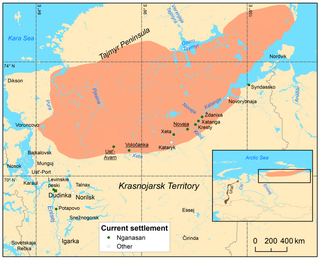| Nganasan | |
|---|---|
| ня” njaʔ | |
| Pronunciation | [nʲaʔ] |
| Native to | Russia |
| Region | Taymyr Autonomous Okrug |
| Ethnicity | 687 Nganasans (2021 census)[1] |
Native speakers | 100 (2020 census)[2] |
| Dialects | |
| Cyrillic script | |
| Language codes | |
| ISO 639-3 | nio |
| Glottolog | ngan1291 |
| ELP | Nganasan |
 | |
 Nganasan is classified as Critically Endangered by the UNESCO Atlas of the World's Languages in Danger (2021). | |
The Nganasan language (formerly called тавгийский, tavgiysky, or тавгийско-самоедский, tavgiysko-samoyedsky in Russian; from the ethnonym тавги, tavgi) is a moribund Samoyedic language spoken by the Nganasan people.
- ^ "Nganasan language, alphabet and pronunciation".
- ^ "Итоги Всероссийской переписи населения 2020 года. Таблица 6. Население по родному языку" [Results of the All-Russian population census 2020. Table 6. population according to native language.]. rosstat.gov.ru. Retrieved 2023-01-03.
- ^ Rantanen, Timo; Tolvanen, Harri; Roose, Meeli; Ylikoski, Jussi; Vesakoski, Outi (2022-06-08). "Best practices for spatial language data harmonization, sharing and map creation—A case study of Uralic". PLOS ONE. 17 (6): e0269648. Bibcode:2022PLoSO..1769648R. doi:10.1371/journal.pone.0269648. PMC 9176854. PMID 35675367.
- ^ Rantanen, Timo, Vesakoski, Outi, Ylikoski, Jussi, & Tolvanen, Harri. (2021). Geographical database of the Uralic languages (v1.0) [Data set]. Zenodo. https://doi.org/10.5281/zenodo.4784188